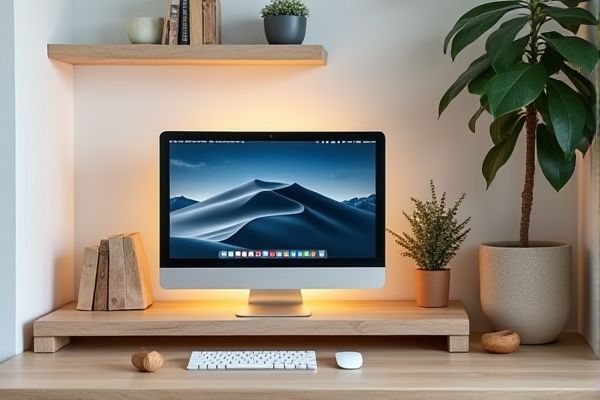
A desktop shelf provides elevated storage space, helping you organize items above your workspace and create more room on your desk, while a desktop tray offers a flat surface to hold papers and smaller items within easy reach. Discover which option better suits your needs and enhances Your workspace efficiency by reading the full article.
Table of Comparison
| Feature | Desktop Shelf | Desktop Tray |
|---|---|---|
| Primary Use | Elevate monitors, organize books and stationery | Hold loose papers, documents, and small office supplies |
| Design | Open flat surface, sometimes tiered | Shallow, rectangular container with raised edges |
| Material | Wood, metal, plastic | Plastic, metal mesh, wood |
| Space Optimization | Creates additional vertical space under monitor | Stackable for multi-level paper organization |
| Portability | Moderately portable, often fixed on desk | Lightweight and easy to move |
| Typical Dimensions | Varies; usually wider and higher | Usually standard letter size or smaller |
| Best For | Enhancing monitor height and workspace display | Managing paperwork and loose small items |
Introduction to Desktop Shelf and Desktop Tray
A desktop shelf maximizes your workspace by adding vertical storage, helping organize books, gadgets, and office supplies efficiently. A desktop tray, on the other hand, offers a compact solution to keep smaller items like pens, papers, and clips easily accessible and neatly contained. Choosing between a desktop shelf and tray depends on your specific needs for space optimization and item accessibility.
Key Differences Between Desktop Shelf and Desktop Tray
A desktop shelf offers elevated storage space, maximizing vertical organization and freeing up the main desk surface, ideal for monitors or books. A desktop tray provides a flat, often portable surface typically used for holding smaller items like stationery or documents, facilitating quick access and easy organization. Key differences include the shelf's focus on vertical elevation and structural support versus the tray's emphasis on portability and surface-level containment.
Design and Structure Comparison
Desktop shelves feature elevated platforms that maximize vertical space, offering multiple tiers for organizing monitors, books, and office supplies. Desktop trays are shallow, flat containers designed for holding papers, stationery, and small items within easy reach, often stackable for compact storage. The design of desktop shelves emphasizes height and accessibility, while trays prioritize simplicity and space-saving functionality.
Space Optimization Capabilities
Desktop shelves offer vertical space optimization by elevating monitors or items, freeing up the surface area for other tools, while desktop trays primarily maximize horizontal space by organizing small items and documents efficiently within reach. Shelves are ideal for creating multi-layered storage on limited desk footprints, whereas trays help declutter by segmenting and grouping essentials in a compact layout. Selecting between a shelf and a tray depends on whether vertical elevation or surface organization better suits your workspace constraints and workflow needs.
Material and Durability Considerations
Desktop shelves typically feature sturdy materials such as solid wood, metal, or high-quality MDF, ensuring long-lasting durability and the ability to support heavier items. Desktop trays are often crafted from lighter materials like plastic or thin metal, prioritizing portability but potentially sacrificing strength and wear resistance. Your choice should reflect the balance between durable support and lightweight convenience based on material composition.
Aesthetics and Workspace Organization
A desktop shelf enhances aesthetics by providing a sleek, elevated surface that keeps monitors, plants, or decorative items neatly displayed, creating a visually appealing workspace. It maximizes organization by freeing up desk surface area underneath for keyboards, notebooks, or office supplies, reducing clutter and improving accessibility. Desktop trays offer compartmentalized storage for small items like pens and paper clips, promoting a tidy environment but with less impact on overall desk aesthetics compared to the minimalist design of shelves.
Ease of Installation and Flexibility
Desktop shelves offer straightforward installation, often requiring minimal tools and mounting hardware, making them easy to set up on various desk surfaces. Desktop trays provide more flexibility with lightweight designs that can be relocated or adjusted without permanent fixtures, ideal for dynamic workspaces. Both options enhance organization, but shelves suit semi-permanent setups while trays excel in adaptability and quick rearrangement.
Cost and Value Analysis
Desktop trays generally offer a lower-cost solution for organizing documents and small items, making them ideal for budget-conscious users seeking immediate functionality. Desktop shelves, while typically involving a higher upfront investment, provide greater durability and increased vertical storage capacity, delivering enhanced long-term value in office space optimization. Evaluating cost versus value involves considering both initial price and the potential for improved productivity and workspace efficiency based on user needs.
Best Use Cases for Desktop Shelves
Desktop shelves are ideal for organizing bulky or frequently used items such as books, binders, or monitors, maximizing vertical space on your desk. They provide easy accessibility while keeping your workspace tidy and reducing clutter, especially in home offices or study areas. Your productivity improves as essential tools and documents stay visible and within reach without sacrificing desk surface area.
Ideal Scenarios for Desktop Trays
Desktop trays are ideal for organizing small office supplies like pens, paper clips, and sticky notes, ensuring a clutter-free workspace. They work well in environments where quick access to frequently used items is essential, such as busy offices or craft rooms. Compact and shallow designs make desktop trays suitable for limited desk space while maintaining visibility and easy retrieval of items.
 homyna.com
homyna.com